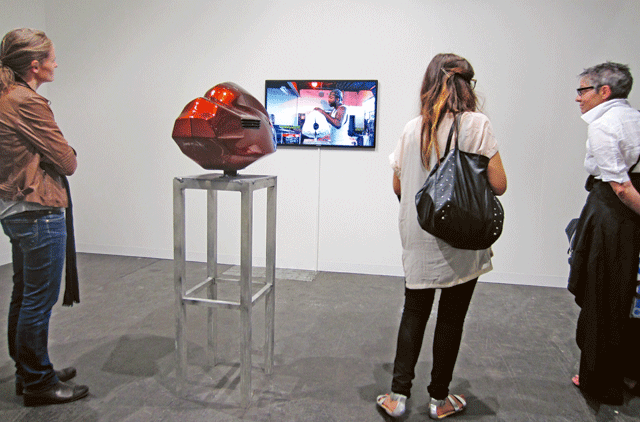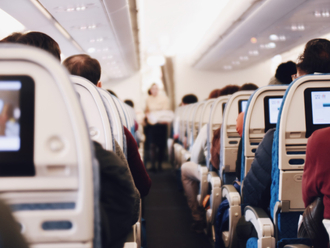The international art set is an assemblage of not just artists, curators, collectors, buyers, galleries and museums but a vortex of high-energy talent, aspirations, egos and million dollar purchases.
At the centre of this feast of art festivals, fairs and biennials around the globe lies Art Basel, considered the world’s premier international art show for modern and contemporary works. Featuring more than 300 leading galleries from across the world and over 2,500 artists, ranging from established stars to the latest generation of emerging talent, this year saw more than 65,000 people attend Art Basel.
The June event for the first time saw the inclusion of two galleries from the UAE. The presence of these galleries, Green Art Gallery and Gallery Isabelle van den Eynde, alongside Galerie Sfeir-Semler from Lebanon, is being seen as a sign of the maturing Middle Eastern art scene and its increasing global presence.
“Having two galleries from the UAE and one from Beirut exhibit at Art Basel is an indication of the region’s growth in regards to its art scene, artists, galleries, institutions and private collectors,” says Marc Spiegler, Director, Art Basel. “We have always felt that Art Basel expands as the art world expands, and it is therefore very important for the UAE to be represented at the event.”
The growing importance of the art scene in the region is also reflected in Art Basel’s decision last year to appoint a VIP relations manager to the Middle East, indicating how seriously they are taking the region.
Yasmin Atassi, director of Green Art Gallery, is of the opinion that any gallery in the world aspires to feature at Art Basel at some point. “This is a huge accomplishment for the gallery; it is, after all, extremely hard to be accepted. But it is also a great opportunity in itself. It offers an ideal platform for the gallery programme and its artists to be noticed by the most important institutions, curators and collectors in the world.”
The gallery entered the Art Statements section of the fair — ideal for emerging artists and conceptual projects — with Palestinian artist Shadi Habib Allah.
Emerging talent
Acceptance to Art Basel is seen as the highest form of recognition and is neither easy nor readily awarded. “It’s a fairly stringent procedure, where the fair selection committee checks a few aspects of the gallery, such as our programme of exhibitions and the artists we represent, and go through the gallery as a whole,” explains Tessa De Caters (pictured below), Director, Gallery Isabelle van den Eynde.
The gallery also participated in Art Statements. The section can also be used to present solo projects by an emerging artist. Gallery Isabelle van den Eynde’s entry was Fictionville by Rokni Haerizadeh, a body of work that includes works on paper from his ongoing Fictionville series alongside his video animation Just What Is It That Makes Today’s Homes So Different, So Appealing?
According to Spiegler, what defines Art Basel is the great quality of galleries exhibiting at the show every year, and the quality of artists they represent. Collectors know that when they come to Art Basel they will discover the highest quality paintings, sculptures, drawings, installations, photographs and videos among other works.
Art Basel also offers a rich cultural dimension. Every day during the fair, Art Basel Conversations and Art Salon present dynamic discussions between prominent members of the international art world, each offering their unique, first-hand perspectives on producing, collecting, and exhibiting art. In addition, Art Basel offers a programme of art interventions, performances and film alongside the presentation of galleries.
Representing the region
So what sort of art are galleries choosing to represent the region? Haerizadeh questions the culture of popular protests and how demonstrations and rallies have become carnivals and media-footage grim theatre. “Haerizadeh is one of the most brilliant artists of his generation. His works are often rooted in occurrences and episodes in national histories, such as Fictionville, which is based on footage from the Iranian protests of 2009, and yet his practice reveals a powerful and unsettling reflection that extends to encompass the human condition at large,” says De Carters.
Shadi’s work, titled S/N: 8F1GNA0021, consists of a sculpture and an accompanying video, which was produced in Miami. The video documents the process of the artist “commissioning” a camera to be stolen in the clandestine marketplace and the labour of fashioning a new “legal” identity on the object. The work represents illicit economies that exist within established forms of circulation and deal with illegal bodies.
Broadening the canvas to a macro level, De Caters acknowledges Art Basel’s significant impetus to what is being seen as the popularity of Middle Eastern art. “Our presence in Art Basel has received impressive media attention. In [the channel] Arte’s TV report on the fair, Rokni was called ‘the best discovery of Basel’s 43rd edition’,” she says.
“His works have been acquired by new collections in Switzerland, France, Belgium and Germany, while curators, art advisers and, of course, the public at large were extremely enthusiastic. We were constantly met with questions and requests, and in that sense too, it has been a wonderful experience,” she adds.
Atassi also believes that exhibiting at Art Basel has given not just the art scene but the galleries themselves a significant boost. “It definitely drew attention to what galleries are doing in the regional art scene, which has developed immensely over the last few years, but which has also been neglected internationally to a certain extent.”
Yet, he says audiences all over the world also need to understand what regional art is all about. Today, the real challenge facing Middle Eastern artists, he says, is being clubbed as Middle Eastern — a term rife with all kinds of unfortunate undertones, especially given the recent unrest in the region.
“There is an expectation that art from the region is meant to address political issues directly,” says Atassi. “This is a dangerous and limiting path and artists need to understand this, yet maintain a critical position of distance and develop their work [while being] fully conscious of this,” he says.









